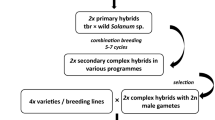Abstract
The nature and extent of past and current hybridization between cultivated potato and wild relatives in nature is of interest to crop evolutionists, taxonomists, breeders and recently to molecular biologists because of the possibilities of inverse gene flow in the deployment of genetically-modified (GM) crops. This research proves that natural hybridization occurs in areas of potato diversity in the Andes, the possibilities for survival of these new hybrids, and shows a possible way forward in case of GM potatoes should prove advantageous in such areas.


Similar content being viewed by others
References
Bernatzky R, Tanksley SD (1986) Methods for detection of single or low copy sequences in tomato on Southern blots. Plant Mol Biol Rep 4(1):37–44
Brush SB, Heath JC, Huaman Z (1981) Dynamics of Andean potato agriculture. Econ Bot 35(1):70–88
Buchmann SL, Jones CE, Colin LJ (1977) Vibratile pollination of Solanum douglasii and Solanum xantii (Solanacea) in Southern California. The Wasman J Biol 35:1–25
Celis BC, Scurrah M, Cowgill S, Chumbiauca S, Green J, Franco J, Main G, Kiezebrink D, Visser R, Atkinson HJ (2004) Environmental biosafety and transgenic potato in a centre of this crop’s diversity. Nature 432:222–225
Cultivarston SA, den Nijs APM, Peloquin SJ, Hanneman RE Jr (1980) The significance of genetic balance to endosperm development in interspecific crosses. Theor Appl Genet 57:5–9
Chen Q, Kawchuk LM, Lynch DR, Goettel MS, Fujimoto DK (2003) Identification of Lte Blfiht, Colorado potato beetle and blackleg resistance in three Mexican and two South American wild @x (1EBN) Solanum species. Am J Potato Res 80:9–19
Ehlenfeldt MK, Hanneman RE Jr (1988) Genetic control of Endosperm Balance Number (EBN): three additive loci in a threshold-like system. Theor Appl Genet 75:825–832
Hawkes JG (1990) The potato: evolution, biodiversity and genetic resources. Smithsonian Institution Press, Washington, DC, 259 pp
Hijmans RJ (2002) Assessing the risk of natural gene flow between wild and genetically modified cultivated potatoes: taxonomic and geographic considerations. Report preparad for Servicio Nacional de Sanidad Agraria (SENASA) Ministerio de Ag, Peru
Huaman Z, Spooner DM (2002) Reclassificatio of landrace populations of cultivated potatoes (Solanum sect. Petota). Am J Bot 89(6):947–965
Jackson SA, Hanneman RE Jr (1996) Potential gene flow between cultivated potato and its wild tuber-bearing relatives: implications for risk assessment of transgenic potatoes. In: 1996 Proceedings biotechnology risk assessment symposium. [on-line]. Information Systems for Biotechnology (ISB), Virginia, USA http://www.isb.vt.edu/brarg/brasym96/jackson96.htm
Jackson SA, Hanneman RE Jr (1999) Crossability between cultivated and wild tuber-and non tuber-bearing solanums. Euphytica 109:51–67
Johns T, Keen S (1986) Ongoing evolution of the potato on the altiplano of western Bolivia. Econ Bot 40(4):409–424
Linder CR (1987) Diversity within traditional potato agriculture in the Peruvian Andes and its relevance to crop evolution. M-S. Thesis Cornell University
Mayer E (1980) Land use in the Andes with special mention of potatoes. Cip, 80 pp
Ochoa CM (1990) The potatoes of South America: Bolivia. Cambridge University Press, Cambridge, UK
Ortiz R (1998) Potato breeding via ploidy manipulations. Plant Breed Rev 16:15–86
Peloquin SJ, Yerk GL, Werner JE, Darmo E (1989) Potato breeding with haploids and 2n gametes. Genome 31:1000–1004
Quiros CF, Brush SB, Douches DS, Zimmerer KS, Huestis G (1990) Biochemical and folk assessment of variability of Andean cultivated potatoes. Econ Bot 44(2):254–266
Ramanna MS (1979) A re-examination of the mechanisms of 2n gamete formation in potato and its implications for breeding. Euphytica 28:537–561
Sanford JC, Hanneman RE (1981) The use of bees for the purpose of inter-mating in potato. Am Potato J 58:481–485
Spooner DM, McLean K, Ramsay G, Waugh R, Bryan GJ (2005) A single domestication for potato based on multilocus amplified fragment length polymorphism genotyping. Proc Natl Acad Sci 102:14694–14699
Thurston D (1991) Andean potato culture: 5,000 years of experience with sustainable agriculture In: Zehnder GM, Powelson ML, Jansson RK, Raman KV (eds) Advances in potato pest biology and management. The American Phytopathological Society (APS Press), St. Paul, Minnesota (USA), ISBN 0-89054-164-7. 1994, pp 6–13
Ugent D (1970) The potato. Science 170:1161–1166
Ugent D (1981) Biogeography and origin of solanum acuale bitter. Phytologia 48(1):85–95
Vos P, Hogers R, Bluker M (1995) AFLP: a new technique for DNA fingerprinting. Nucleic Acids Res 23:4407–4414
Zimmerer KS, Spooner DM (1991) Geographical approaches to crop conservation: the partitioning of genetic diversity in Andean potatoes. Econ Bot 45(2):176–189
Acknowledgements
This research was financed by the International Cooperation Program for Development from the European Union (ICFP599A4PR01). We are grateful to CIP and INIEA for the greenhouse and experimental fields facilities and staff that collaborated; to Eutropio Contreras and his family and Raul Canto for helping with planting, monitoring and evaluations of these trials on growing and selecting the plant material. We are also very grateful to Dr. Claus Rasmusen from the University of Illinois for identification of insect pollinators.
Author information
Authors and Affiliations
Corresponding author
Additional information
Maria Scurrah and Carolina Celis-Gamboa contributed equally to this manuscript.
Rights and permissions
About this article
Cite this article
Scurrah, M., Celis-Gamboa, C., Chumbiauca, S. et al. Hybridization between wild and cultivated potato species in the Peruvian Andes and biosafety implications for deployment of GM potatoes. Euphytica 164, 881–892 (2008). https://doi.org/10.1007/s10681-007-9641-x
Received:
Accepted:
Published:
Issue Date:
DOI: https://doi.org/10.1007/s10681-007-9641-x




